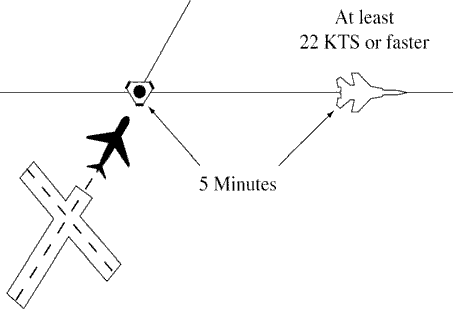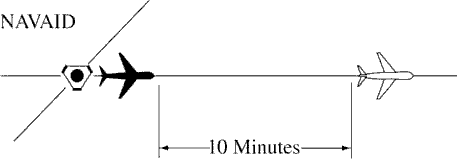Section 4. Longitudinal Separation
- Views Views: 834
- Last updated Last updated:
-
Sub-pages:
Section 4. Longitudinal Separation
6-4-1. APPLICATION
Separate aircraft longitudinally by requiring them to do one of the following, as appropriate:
- Depart at a specified time.
- Arrive at a fix at a specified time.
- PHRASEOLOGY
- CROSS (fix) AT OR BEFORE (time).
- CROSS (fix) AT OR AFTER (time).
- Hold at a fix until a specified time.
- Change altitude at a specified time or fix.
6-4-2. MINIMA ON SAME, CONVERGING, OR CROSSING COURSES
Separate aircraft on the same, converging, or crossing courses by an interval expressed in time or distance, using the following minima:
- When the leading aircraft maintains a speed at least 44 knots faster than the following aircraft - 5 miles between DME equipped aircraft; RNAV equipped aircraft using ATD; and between DME and ATD aircraft provided the DME aircraft is either 10,000 feet or below or outside of 10 miles from the DME NAVAID, or 3 minutes between other aircraft if, in either case, one of the following conditions is met:
- A departing aircraft follows a preceding aircraft which has taken off from the same or adjacent airport. (See FIG 6-4-1.)
FIG 6-4-1 Minima on Same Course 44 Knots or More Separation 
- A departing aircraft follows a preceding en route aircraft which has reported over a fix serving the departure airport. (See FIG 6-4-2.)
FIG 6-4-2 Minima on Converging Courses 44 Knots or More Separation 
- An en route aircraft follows a preceding en route aircraft which has reported over the same fix. (See FIG 6-4-3.)
FIG 6-4-3 Minima on Crossing Courses 44 Knots or More Separation 
- A departing aircraft follows a preceding aircraft which has taken off from the same or adjacent airport. (See FIG 6-4-1.)
- When the leading aircraft maintains a speed at least 22 knots faster than the following aircraft - 10 miles between DME equipped aircraft; RNAV equipped aircraft using ATD; and between DME and ATD aircraft provided the DME aircraft is either 10,000 feet or below or outside of 10 miles from the DME NAVAID; or 5 minutes between other aircraft if, in either case, one of the following conditions exists:
- A departing aircraft follows a preceding aircraft which has taken off from the same or an adjacent airport. (See FIG 6-4-4.)
FIG 6-4-4 Minima on Same Course 22 Knots or More Separation 
- A departing aircraft follows a preceding en route aircraft which has reported over a fix serving the departure airport. (See FIG 6-4-5.)
FIG 6-4-5 Minima on Converging Courses 22 Knots or More Separation 
- An en route aircraft follows a preceding en route aircraft which has reported over the same fix. (See FIG 6-4-6.)
FIG 6-4-6 Minima on Crossing Courses 22 Knots or More Separation 
- A departing aircraft follows a preceding aircraft which has taken off from the same or an adjacent airport. (See FIG 6-4-4.)
- When an aircraft is climbing or descending through the altitude of another aircraft:
- Between DME equipped aircraft; RNAV equipped aircraft using ATD; and between DME and ATD aircraft provided the DME aircraft is either 10,000 feet or below or outside of 10 miles from the DME NAVAID- 10 miles, if the descending aircraft is leading or the climbing aircraft is following. (See FIG 6-4-7 and FIG 6-4-8.)
FIG 6-4-7 Descending Through Another Aircraft's Altitude DME Separation 
FIG 6-4-8 Climbing Through Another Aircraft's Altitude DME Separation 
- Between other aircraft - 5 minutes, if all of the following conditions are met: (See FIG 6-4-9 and FIG 6-4-10.)
- (a) The descending aircraft is leading or climbing aircraft is following.
- (b) The aircraft are separated by not more than 4,000 feet when the altitude change started.
- (c) The change is started within 10 minutes after a following aircraft reports over a fix reported over by the leading aircraft or has acknowledged a clearance specifying the time to cross the same fix.
- Between RNAV aircraft that are operating along an RNAV route that is eight miles or less in width- 10 miles provided the following conditions are met:
- (a) The descending aircraft is leading or the climbing aircraft is following.
- (b) The aircraft were separated by not more than 4,000 feet when the altitude change started.
FIG 6-4-9 Descending Through Another Aircraft's Altitude Timed Separation 
FIG 6-4-10 Climbing Through Another Aircraft's Altitude Timed Separation 
- Between DME equipped aircraft; RNAV equipped aircraft using ATD; and between DME and ATD aircraft provided the DME aircraft is either 10,000 feet or below or outside of 10 miles from the DME NAVAID- 10 miles, if the descending aircraft is leading or the climbing aircraft is following. (See FIG 6-4-7 and FIG 6-4-8.)
- When the conditions of subparagraphs a, b, or c cannot be met- 20 miles between DME equipped aircraft; RNAV equipped aircraft using ATD; and between DME and ATD aircraft provided the DME aircraft is either 10,000 feet or below or outside of 10 miles from the DME NAVAID; or 10 minutes between other aircraft. (See FIG 6-4-11, FIG 6-4-12, FIG 6-4-13, FIG 6-4-14, FIG 6-4-15, and FIG 6-4-16.)
FIG 6-4-11 Minima for Same Course Separation 
FIG 6-4-12 Minima for Crossing Courses Separation 
FIG 6-4-13 Minima for Same Course Separation 
FIG 6-4-14 Minima for Crossing Courses Separation 
FIG 6-4-15 Climbing Through Another Aircraft's Altitude Separation 
FIG 6-4-16 Descending Through Another Aircraft's Altitude Separation 
- Between aircraft, when one aircraft is using DME/ATD and the other is not- 30 miles if both the following conditions are met: (See FIG 6-4-17 and FIG 6-4-18.)
FIG 6-4-17 Minima for Same Course Separation 
FIG 6-4-18 Minima for Crossing Courses Separation 
- The aircraft using DME/ATD derives distance information by reference to the same NAVAID or waypoint over which the aircraft not using DME/ATD has reported.
- The aircraft not using DME/ATD is within 15 minutes of the NAVAID.
6-4-3. MINIMA ON OPPOSITE COURSES
Separate aircraft traveling opposite courses by assigning different altitudes consistent with the approved vertical separation from 10 minutes before, until 10 minutes after they are estimated to pass. Vertical separation may be discontinued after one of the following conditions is met: (See FIG 6-4-19.)
FIG 6-4-19 Minima for Opposite Courses Separation 
NOTE: RNAV route segments that have been expanded in the proximity to reference facilities for slant-range effect are not to be considered “expanded” for purposes of applying separation criteria in this paragraph.
- Both aircraft have reported passing NAVAIDs, DME fixes, or waypoints indicating they have passed each other.
(See FIG 6-4-20.)
FIG 6-4-20 Minima for Opposite Courses Separation 
NOTE: It is not intended to limit application of this procedure only to aircraft operating in opposite directions along the same airway or radial. This procedure may also be applied to aircraft established on diverging airways or radials of the same NAVAID.
- Both aircraft have reported passing the same intersection/waypoint and they are at least 3 minutes apart.
- Two RNAV aircraft have reported passing the same position and are at least 8 miles apart if operating along a route that is 8 miles or less in width; or 18 miles apart if operating along any route segment that is greater than 8 miles in width; except that 30 miles must be applied if operating along that portion of any route segment defined by a navigation station requiring extended usable distance limitations beyond 130 miles.
- An aircraft utilizing RNAV and an aircraft utilizing VOR have reported passing the same position and the RNAV
aircraft is at least 4 miles beyond the reported position when operating along a route that is 8 miles or less in
width; 9 miles beyond the point when operating along any route segment that is greater than 8 miles in width;
except that 15 miles must be applied if operating along that portion of any route segment defined by a navigation
station requiring extended usable distance limitation beyond 130 miles; or 3 minutes apart whichever is greater.
NOTE: Except for GNSS-equipped aircraft /G, /L, /S, and /V, not on a random impromptu route, paragraph 5-5-1, Application, requires radar separation be provided to RNAV aircraft operating at and below FL450 on Q routes or random RNAV routes, excluding oceanic airspace.
6-4-4. SEPARATION BY PILOTS
When pilots of aircraft on the same course in direct radio communication with each other concur, you may authorize the following aircraft to maintain longitudinal separation of 10 minutes; or 20 miles between DME equipped aircraft; RNAV equipped aircraft using ATD; and between DME and ATD aircraft provided the DME aircraft is either 10,000 feet or below or outside of 10 miles from the DME NAVAID.
- PHRASEOLOGY
- MAINTAIN AT LEAST ONE ZERO MINUTES/TWO ZERO MILES SEPARATION FROM (ident).
6-4-5. RNAV AIRCRAFT ALONG VOR AIRWAYS/ROUTES
Advise the pilot to use DME distances when applying DME separation to an RNAV aircraft operating along VOR airways/routes.
- PHRASEOLOGY
- USE DME DISTANCES.
NOTE: ATD derived from area navigation devices having slant-range correction will not coincide with the direct DME readout.
